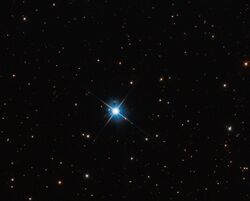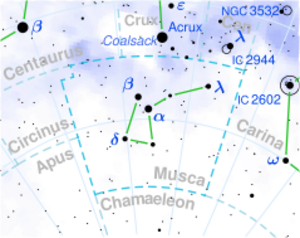Astronomy:LP 145-141
Coordinates: ![]() 11h 45m 42.9205s, −64° 50′ 29.459″
11h 45m 42.9205s, −64° 50′ 29.459″
| Observation data Epoch J2000.0 Equinox (celestial coordinates) | |
|---|---|
| Constellation | Musca[2] |
| Right ascension | 11h 45m 42.91694s[3] |
| Declination | −64° 50′ 29.4620″[3] |
| Apparent magnitude (V) | 11.50[4] |
| Characteristics | |
| Spectral type | DQ6[5] |
| U−B color index | -0.59[4] |
| B−V color index | +0.19[4] |
| Astrometry | |
| Proper motion (μ) | RA: 2661.640[3] mas/yr Dec.: -344.933[3] mas/yr |
| Parallax (π) | 215.6753 ± 0.0181[3] mas |
| Distance | 15.123 ± 0.001 ly (4.6366 ± 0.0004 pc) |
| Details | |
| Mass | 0.56 ± 0.08[6] M☉ |
| Radius | 0.01 R☉ |
| Luminosity | 0.0005[7] L☉ |
| Surface gravity (log g) | 8.27 ± 0.05[7] cgs |
| Temperature | 8,500 ± 300[7] K |
| Age | (as white dwarf)[7] 1.44 Gyr |
| Other designations | |
| Database references | |
| SIMBAD | data |
Location of LP 145-141 in the constellation Musca | |
LP 145-141, also known as LAWD 37,[4] is an isolated white dwarf located 15.1 light-years (4.6 parsecs) from the Solar System in the constellation Musca.[16] According to a 2009 paper, it is the fourth closest known white dwarf to the Sun (after Sirius B, Procyon B, and van Maanen's star.)[17]
History of observations
LP 145-141 is known at least from 1917, when its proper motion was published by R. T. A. Innes and H. E. Wood in Volume 37 of Circular of the Union Observatory.[18] The corresponding designation is UO 37.[10] (Note: this designation is not unique for this star, that is all other stars, listed in the table in the Volume 37 of this Circular, also could be called by this name).
Space motion
LP 145-141 may be a member of the Wolf 219 moving group, which has seven possible members. These stars share a similar motion through space, which may indicate a common origin.[19] This group has an estimated space velocity of 160 km/s and is following a highly eccentric orbit through the Milky Way galaxy.[20]
Properties
White dwarfs are no longer generating energy at their cores through nuclear fusion, and instead are steadily radiating away their remaining heat. LP 145-141 has a DQ spectral classification, indicating that it is a rare type of white dwarf which displays evidence of atomic or molecular carbon in its spectrum.[21]
In 2019, LP 145-141 was observed passing in front of a more distant star. The bending of starlight by the gravitational field of LP 145-141 observed by the Hubble Space Telescope allowed its mass to be directly measured. The estimated mass of LP 145-141 is 0.56±0.08 M☉, which fits the expected range of a white dwarf with a carbon-oxygen core. This measurement marked the first direct gravitational mass determination of a single white dwarf.[6]
LP 145-141 has only 56% of the Sun's mass,[6] but it is the remnant of a massive main-sequence star that had an estimated 4.4 solar masses.[22] While it was on the main sequence, it probably was a spectral class B star (in the range B4-B9).[23] Most of the star's original mass was shed after it passed into the asymptotic giant branch stage, just prior to becoming a white dwarf.
Search for companions
A survey with the Hubble Space Telescope revealed no visible orbiting companions, at least down to the limit of detection.[24][5]
Its proximity, mass and temperature have led to it being considered a good candidate to look for Jupiter-like planets. Its relatively large mass and high temperature mean that the system is relatively short-lived and hence of more recent origin.[22]
Hipparcos-Gaia proper motion shows an anomaly that hints to the presence of an exoplanet that has a mass of either 0.44 or 0.60 |♃|J}}}}}} which is between Saturn and Jupiter.[25][26]
See also
References
- ↑ "LAWD 37". 2 February 2023. https://esahubble.org/images/heic2301a/.
- ↑ "Constellation boundaries". Centre de Données astronomiques de Strasbourg. http://vizier.u-strasbg.fr/vizier/VizieR/constellations.htx.
- ↑ 3.0 3.1 3.2 3.3 Vallenari, A. et al. (2022). "Gaia Data Release 3. Summary of the content and survey properties". Astronomy & Astrophysics. doi:10.1051/0004-6361/202243940 Gaia DR3 record for this source at VizieR.
- ↑ 4.0 4.1 4.2 4.3 "LAWD 37". SIMBAD. Centre de données astronomiques de Strasbourg. http://simbad.u-strasbg.fr/simbad/sim-basic?Ident=LAWD+37.
- ↑ 5.0 5.1 Daniel J. Schroeder (February 2000). "A Search for Faint Companions to Nearby Stars Using the Wide Field Planetary Camera 2". The Astronomical Journal 119 (2): 906–922. doi:10.1086/301227. Bibcode: 2000AJ....119..906S.
- ↑ 6.0 6.1 6.2 McGill, P.; Anderson, J.; Casertano, S.; Sahu, K.C. (March 2023), "First semi-empirical test of the white dwarf mass-radius relationship using a single white dwarf via astrometric microlensing", Monthly Notices of the Royal Astronomical Society 520 (1): 259–280, doi:10.1093/mnras/stac3532, https://doi.org/10.1093/mnras/stac3532, retrieved 2023-02-08
- ↑ 7.0 7.1 7.2 7.3 Table 2, P. Bergeron; S. K. Leggett; María Teresa Ruiz (April 2001). "Photometric and Spectroscopic Analysis of Cool White Dwarfs with Trigonometric Parallax Measurements". Astrophysical Journal Supplement Series 133 (2): 413–449. doi:10.1086/320356. Bibcode: 2001ApJS..133..413B.
- ↑ "Gl 440". Preliminary Version of the Third Catalogue of Nearby Stars. 1991. http://webviz.u-strasbg.fr/viz-bin/VizieR-5?-source=V/70A&Name=Gl%20440.
- ↑ Perryman (1997). "HIP 57367". The Hipparcos and Tycho Catalogues. http://webviz.u-strasbg.fr/viz-bin/VizieR-5?-source=I/239/hip_main&HIP=57367.
- ↑ 10.0 10.1 Porter, J. G.; Yowell, E. J.; Smith, E. S. (1930). "A catalogue of 1474 stars with proper motion exceeding four-tenths year.". Publications of the Cincinnati Observatory 20: 1–32. Bibcode: 1930PCinO..20....1P. Page 16 (Ci 20 658).
- ↑ Luyten, Willem Jacob (1979). "LHS 30". LHS Catalogue, 2nd Edition. http://webviz.u-strasbg.fr/viz-bin/VizieR-5?-source=I/87B&LHS=30.
- ↑ Luyten, Willem Jacob (1979). "NLTT 28447". NLTT Catalogue. http://webviz.u-strasbg.fr/viz-bin/VizieR-5?-source=I/98A&recno=28447.
- ↑ "GCTP 2716". The General Catalogue of Trigonometric Stellar Parallaxes. 1995. http://webviz.u-strasbg.fr/viz-bin/VizieR-5?-source=I/238A/picat&GCTP=2716.
- ↑ Perryman (1997). "HIP 57367". The Hipparcos and Tycho Catalogues. http://webviz.u-strasbg.fr/viz-bin/VizieR-5?-source=I/239/tyc_main&HIP=57367.
- ↑ Hog (2000). "TYC 8981-4417-1". The Tycho-2 Catalogue. http://webviz.u-strasbg.fr/viz-bin/VizieR-5?-source=I/259&TYC1=8981&TYC2=4417&TYC3=1.
- ↑ The Astronomical Journal 123 (4): 2002–2009. April 2002. doi:10.1086/339315. Bibcode: 2002AJ....123.2002H.
- ↑ Table 1, Sion Edward M (2009). "The white dwarfs within 20 parsecs of the sun: kinematics and statistics". The Astronomical Journal 138 (6): 1681–1689. doi:10.1088/0004-6256/138/6/1681. Bibcode: 2009AJ....138.1681S.
- ↑ Innes & Wood (1917). Page 290 (see string 41).
- ↑ Eggen, O. J.; Greenstein, J. L. (1965). "Spectra, colors, luminosities, and motions of the white dwarfs". Astrophysical Journal 141: 83–108. doi:10.1086/148091. Bibcode: 1965ApJ...141...83E. — see table 5.
- ↑ Bell, R. A. (1962). "Observations of some southern white dwarfs". The Observatory 82: 68–71. Bibcode: 1962Obs....82...68B.
- ↑ Kawaler, S.; Dahlstrom, M. (2000). "White Dwarf Stars". American Scientist 88 (6): 498. doi:10.1511/2000.6.498. Bibcode: 2000AmSci..88..498K. http://www.americanscientist.org/template/AssetDetail/assetid/23825. Retrieved 2007-07-19.
- ↑ 22.0 22.1 Burleigh, M. R.; Clarke, F. J.; Hodgkin, S. T. (April 2002). "Imaging planets around nearby white dwarfs". Monthly Notices of the Royal Astronomical Society 331 (4): L41–L45. doi:10.1046/j.1365-8711.2002.05417.x. Bibcode: 2002MNRAS.331L..41B.
- ↑ Siess, Lionel (2000). "Computation of Isochrones". Institut d'Astronomie et d'Astrophysique, Université libre de Bruxelles. http://astropc0.ulb.ac.be/~siess/server/iso.html.
- ↑ Jao, Wei-Chun; Henry, Todd J.; Subasavage, John P.; Brown, Misty A.; Ianna, Philip A.; Bartlett, Jennifer L.; Costa, Edgardo; Méndez, René A. (2005). "The Solar Neighborhood. XIII. Parallax Results from the CTIOPI 0.9 Meter Program: Stars with mu >= 1.0" yr-1 (MOTION Sample)". The Astronomical Journal 129 (4): 1954–1967. doi:10.1086/428489. Bibcode: 2005AJ....129.1954J.
- ↑ Kervella, Pierre; Arenou, Frédéric; Thévenin, Frédéric (2022-01-01). "Stellar and substellar companions from Gaia EDR3. Proper-motion anomaly and resolved common proper-motion pairs". Astronomy and Astrophysics 657: A7. doi:10.1051/0004-6361/202142146. ISSN 0004-6361. https://ui.adsabs.harvard.edu/abs/2022A&A...657A...7K.
- ↑ Kervella, Pierre; Arenou, Frédéric; Mignard, François; Thévenin, Frédéric (2019-03-01). "Stellar and substellar companions of nearby stars from Gaia DR2. Binarity from proper motion anomaly". Astronomy and Astrophysics 623: A72. doi:10.1051/0004-6361/201834371. ISSN 0004-6361. https://ui.adsabs.harvard.edu/abs/2019A&A...623A..72K.
External links
 |



